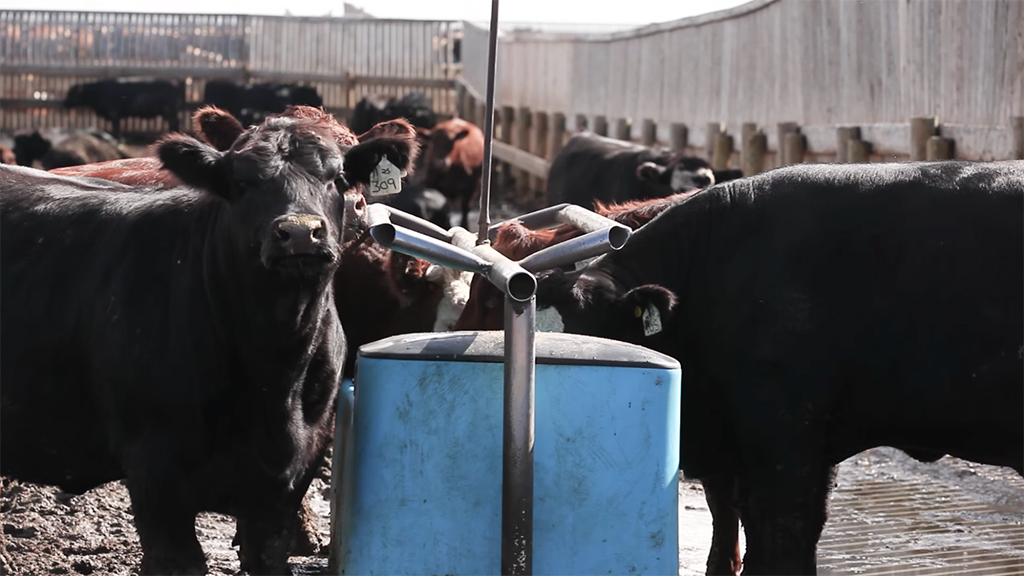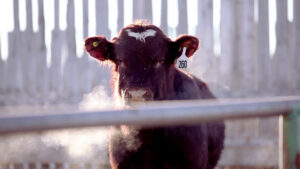Fast Action at the Watering Hole🎙️
This article written by Dr. Reynold Bergen, BCRC Science Director, originally appeared in the December 2023 issue of Canadian Cattlemen magazine and is reprinted on BeefResearch.ca with permission of the publisher.
CLICK THE PLAY BUTTON TO LISTEN TO THIS POST:

Antibiotic resistance threatens the effective prevention and treatment of disease in both humans and animals. When microbes are exposed to an antibiotic, those that are susceptible to that antibiotic die out. Those that are resistant to it survive, thrive, reproduce, pass on their resistance genes on to their descendants and become more common. If those surviving bacteria cause disease, then it’s bad news for health, because that antibiotic won’t be as effective for treating that disease anymore. But it turns out that even “bystander” bacteria may play a role in antibiotic resistance.
Both antibiotics and antibiotic resistance are completely natural. Microbes produce antibiotics as defensive and offensive weapons to help them compete for space and resources in their environment. In fact, most modern antibiotics were derived from drugs that were originally isolated from different species of soil bacteria. So, it’s not surprising that antibiotic resistance is also found in the environment – microbes naturally evolve resistance to defend themselves against the antibiotics that other microbes produce. Researchers find antibiotic resistant bacteria in glaciers and other locations that have never seen modern humans or modern antibiotics. It’s a subterranean arms race.
In an arms race, shadowy arms dealers connect people with weapons to people who want weapons. Normally harmless bacteria found in water may be the arms dealers in the feedlot’s antibiotic resistance arms race. Tony Ruzzini and colleagues recently demonstrated this (Insight into antimicrobial resistance at a new beef cattle feedlot in western Canada).
What They Did
The research team collected water samples from a new dugout and new water bowls in eight empty pens at a brand-new feedlot that opened in the fall of 2021. Nineteen different groups of bacteria from those water samples were tested for resistance to the different antibiotics used in the feedlot. More water samples were collected and tested weekly over eight weeks, as feeder cattle filled the pens. On arrival, calves deemed to be at a higher risk for bovine respiratory disease (BRD) were given Draxxin, lower risk calves were given oxytetracycline, and the feed contained Tylan to control liver abscesses. Cattle that developed clinical signs of BRD were treated with Excede, Florkem or Forcyl according to the health protocol the feedlot and their veterinary consultant had developed. Antibiotic resistance genes from bacteria in the water samples were compared to antibiotic resistance genes in BRD bacteria collected in earlier studies (Mannheimia hemolytica, Histophilus somni, and Pasteurella multocida).
What They Learned
Water samples collected before the cattle arrived: bacteria resistant to Florkem and Draxxin were found in the dugout and some of the water bowls, even before cattle began to enter the feedlot. The environment was a natural reservoir for these antibiotic resistant bacteria, albeit at low levels.
Water samples after the cattle arrived: Resistance to each antibiotic was found in some water bowl samples as early as the first week cattle began arriving. Water bowls in all pens contained bacteria resistant to each antibiotic by the end of the eighth week, likely from contact with the cattle treated with antibiotics on arrival.
Antibiotic resistance in water bowls vs. BRD bacteria: Even though water bowls and the bovine respiratory tract are very, very different environments, there was considerable overlap between the antibiotic resistance genes (and multidrug resistance patterns) found in water bowls and BRD bacteria. That’s what makes these results important. Bacteria are not like mammals. Mammals can only spread genes by mating with others of their kind, and genetic change takes place slowly, over generations. Bacteria can leak whole sets of genes into the environment and absorb sets of genes leaked by other bacteria. This can occur even between very distantly related species of bacteria. Entirely different species of bacteria can also mate and share sets of antibiotic resistance genes. These sets of genes often have functions related to antibiotic resistance, some of which would occur naturally, even in the absence of antibiotic use. This means that bacteria from the water bowl may spread antibiotic resistance genes to BRD bacteria from the respiratory tract, and vice versa. This would be like penning a pig and a cow together overnight, only to find a pig with horns and a cow with a curly tail the next morning.
More research would be needed to determine whether cleaning water bowls regularly might help manage the spread of antibiotic resistant bacteria in the feedlot. Water bowls may also become a convenient place to monitor antibiotic resistance (especially compared to deep nasopharyngeal swabs). For example, the researchers reported an abundance of Moraxella bacteria in water bowls. Moraxella species make up most of the bacteria living in the nose of beef cattle.

So, What Does This Mean… to You?
Antibiotic resistance has been around ever since bacteria first appeared and will never go away. That’s why responsible antibiotic use is so important to ensure antibiotics remain effective. Your veterinarian (and doctor) can help.
Bottom line: BRD can spread among cattle when they congregate at the water bowl. But water bowls might also be a spot where antibiotic resistance spreads among bacteria and adjacent pens, and might present an opportunity to help manage antibiotic resistance.
The Beef Cattle Research Council is funded by the Canadian Beef Cattle Check-Off. The BCRC partners with Agriculture and Agri-Food Canada, provincial beef industry groups and governments to advance research and technology transfer supporting the Canadian beef industry’s vision to be recognized as a preferred supplier of healthy, high-quality beef, cattle, and genetics.
Click here to subscribe to the BCRC Blog and receive email notifications when new content is posted.
The sharing or reprinting of BCRC Blog articles is typically welcome and encouraged, however this article requires permission of the original publisher.
We welcome your questions, comments and suggestions. Contact us directly or generate public discussion by posting your thoughts below.